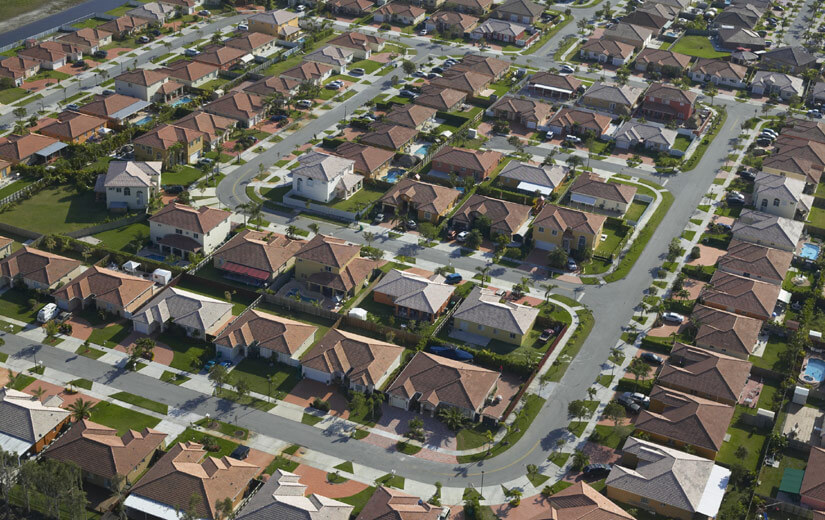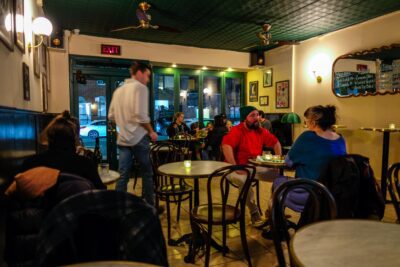Is Living In New York City Now the Same as Living In a Suburb?
New Yorkers have long lamented the encroaching “mallification” and “dormification” and, yes, “surbabanization” of their city streets. Despite New York being one of the most recognizable urban environments in the world, the past couple of decades of rapid gentrification and the encroachment of chain drugstores and coffee spots and banks (oh, the banks! even our bikes are banks or something) have contributed to a sneaking feeling that maybe, just maybe, New York City is not all that different from the areas that surround it. And, after all, Brooklyn—which, if it were its own city, would be the 4th most populous in America—is actually thought of as America’s first suburb. That suburban designation changed over the years as, first, Brooklyn was incorporated into the greater City of New York in 1898, and then later as it rapidly became a symbol of an urban environment itself. However, as much as it’s impossible to deny that New York City still bears many of the hallmarks of an urban landscape, has it now—with its low crime rates, increased number of young families, and strong public school system—evolved into, well, into another Westchester?
An article from New Geography (recently picked up by Business Insider), “Gentrification As an End Game, and the Rise of ‘Sub-Urbanity,'” thinks exactly that—New York is rapidly becoming no different from, say, Chappaqua or Scarsdale. In his piece, Richie Piiparinen writes that “the most recent ‘return-to-city’ movement is largely fueled by younger suburbanites who are tired of missing out on big city action,” but that because their role models are “Chandler, Kramer, and Carrie” instead of Patti Smith or Lou Reed, they are contributing to the creation of “big city suburbanization,” wherein a city maintains some of its urban “vitality,” but has an unignorable number of “suburban comforts.” Piiparinen worries that “this bodes ill for alpha dog cities in that vanilla-ing a people and a place is a death knell to collective urgency, if only because comfort puts to sleep the burn that has traditionally sparked the next generation of ideas.” And he further fears that the suburbanization of the city is bad because it isn’t happening as a by-product of the influx of young, suburban-raised men and women, rather it is the point of why they are coming here. They don’t actually crave “the city” as anything more than a place that they think they are supposed to be living, at least for a little while.
But so, how do we prevent the blandness and stagnancy associated with the suburbs—those bedroom communities that seem to be only suited for the very young and the, well, not very young at all—from completely taking over our city? Or do we not need to do anything at all? Will the exodus of comfort-craving ex-suburbanites happen on its own? Piiparinen is confident that “there will be a growing unhappiness with sub-urbanity that’s going to create for a lot of people left wanting, be they young suburbanites longing for urban authenticity or indigenous urbanites who are tired of the schtick,” and that, because there will be some kind of exodus, “cities would do well to prepare for the ‘return-of-the-city movement.’” And so all that is well and good—I feel pretty prepared for the “return-of-the-city” movement, but that’s mostly because I don’t really feel like there’s been any end to the city that I live in anyway—but what do we do before all the wannabe Carries leave? How do we make sure that there isn’t a complete suburbanization in the meantime? Or maybe, there hasn’t even been one in the first place? I mean, I don’t completely disagree with Piiparinen’s thesis that there has been a “vanilla-ing” of big cities, but I see that mostly as being a problem in the commercial realm with the intrusion of so many big chains on the city streets. However, despite the proliferation of Starbucks and Dunkin Donuts, the last decade has also seen a huge rise in independently owned coffee houses and other small dining spots. And while the long-ago spirit of Greenwich Village might have been lost to the high rents and ubiquity of NYU students, it’s impossible to dismiss the ongoing vitality of the outer boroughs where, even with the criminally high rents, artists have found a way to continue to create and display their work.
New York, no matter how much it reflects its newest inhabitants (be they ex-suburbanites craving comfort or ex-suburbanites craving adventure), will never be fully suburban. No matter how “comfortable” the city becomes, it can’t totally lose its vibrancy and it can’t lose the fundamental urban experience of living and working and interacting with a huge variety of people from every walk of life. That spirit just might not be located in the same places as it used to be. But hasn’t that always been the case? Hasn’t New York been transforming from day one? Expanding and mutating and guaranteeing that as soon as you think you know it, you’re going to be surprised by what happens next? In a word, yes. Sure, it’s possible to live in a secluded enclave in this city, be it Murray Hill or Bensonhurst, and be just as provincial as someone from Oyster Bay or Cos Cob, but in all likelihood you’ll also be spending most of your day in the presence of people who are not like you and who are from all different walks of life. That is the beauty of living in this city, and that is why it attracts so many different people from all over the world (not just the suburbs! New York City is the most language diverse place in the world).
And so, yes, this city is tough to live in and some parts of it seem about as accessible as a gated suburban community, but that’s sort of how it’s always been. The main thing that’s important to foster is the sense of community and civic responsibility that is possible maybe only in a big city. In a privileged suburb (which, due to high costs of living are by nature exclusionary places), it’s possible to live in a complete bubble and not worry about how anyone else is getting by. There’s no need to foster a community, because it’s already a self-selecting unit. But in a city like New York, with its huge ethnic diversity and large income inequality, there’s an imperative to build a community that will almost necessarily include people that are not like you. This is the magic of a city. Are we in danger of losing that in New York if we continue to have an influx of ultra-wealthy people and the continued construction of incredibly expensive housing? Perhaps. But that’s why it’s so important to preserve the diversity of New York, fight for affordable housing and good public schools and maintain the integrity of what is still one of the most vibrant urban areas on earth. Because, really, while we might not be in imminent danger of becoming a satellite Jersey town, we don’t want to stray any farther down that path.
Follow Kristin Iversen on twitter @kmiversen
You might also like 





















